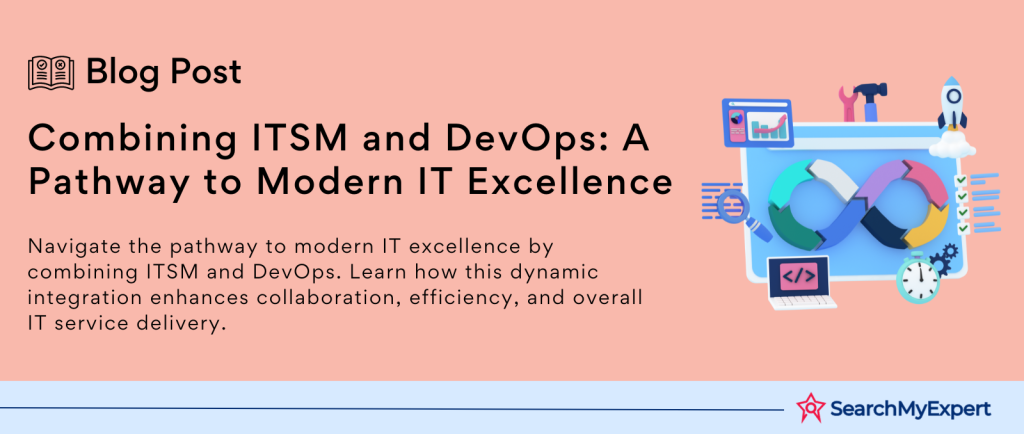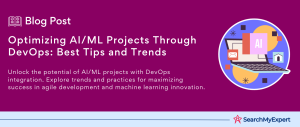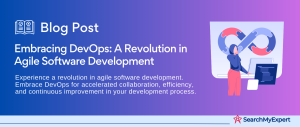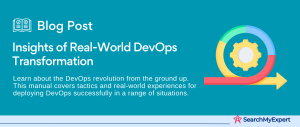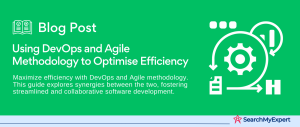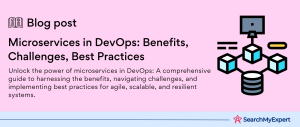DevOps and IT Service Management: Bridging the Gap for Efficient Operations
Defining DevOps and IT Service Management (ITSM)
- DevOps: A modern, transformative philosophy in software development, DevOps seamlessly blends development (Dev) and operations (Ops) teams. It’s a cultural shift, leveraging automation and new practices to increase software deployment speed and improve service reliability.
- IT Service Management (ITSM):
Rooted in a more traditional landscape, ITSM focuses on delivering IT services to meet business needs. It’s about managing IT operations through structured processes and service lifecycle management, primarily influenced by frameworks like ITIL (IT Infrastructure Library).
Historical Context: From Silos to Synergy
DevOps: Breaking Down Barriers
- Era of Isolation:
Traditionally, development and operations teams worked in silos, causing bottlenecks in software delivery. - Agile Influence:
Influenced by Agile methodologies, DevOps emerged to address these inefficiencies, advocating for continuous integration and delivery.
ITSM: Evolving Service Delivery
- Early IT Management: Initially, IT management was about keeping systems running and resolving issues.
- Service-Centric Shift:
ITSM evolved to focus on delivering IT as a service, aligning IT processes with business objectives and customer needs.
Convergence: Shared Goals, Overlapping Practices
Growing Together: DevOps and ITSM, once seen as distinct, are now converging. This integration is driven by:
- Shared Objectives: Both aim to enhance service delivery, improve quality, and ensure customer satisfaction.
- Overlapping Practices: Practices like automation, continuous feedback, and process optimization are common in both.
- Need for Collaboration:
The rapid pace of technology demands a collaborative approach, blending the agility of DevOps with the structure of ITSM.
As we delve deeper into the synergies and distinctions between DevOps and ITSM, we uncover the essentials of modern IT operations, shaping a collaborative and efficient future.
Key Principles and Frameworks in DevOps and ITSM
Core Principles of DevOps
- Collaboration:
Breaking down silos, fostering a culture of open communication and teamwork between Dev and Ops. - Automation: Streamlining processes (e.g., testing, deployment) to increase efficiency and reduce human error.
- Continuous Improvement: An iterative approach, constantly seeking to refine and optimize processes and products.
- Rapid Delivery: Frequent and reliable releases through Continuous Integration/Continuous Deployment (CI/CD).
- Customer-Centric Action:
Aligning development with customer needs and feedback to deliver valuable solutions.
ITSM Frameworks: ITIL 4 and Beyond
ITIL 4: A holistic approach to ITSM, focusing on:
- Value Co-Creation: Collaborating with stakeholders to maximize value.
- Customer Focus:
Prioritizing customer needs and experience. - Holistic Approach:
Considering all aspects (people, processes, technology) in service management. - Other Frameworks:
COBIT, ISO/IEC 20000, providing additional structures and best practices in ITSM.
Synergy: DevOps Practices Meeting ITSM Frameworks
Aligning Objectives for Enhanced Efficiency and Quality:
CI/CD in DevOps and ITSM:
- DevOps champions CI/CD for rapid and reliable software release.
- ITSM integrates these practices within its service lifecycle, ensuring that rapid deployment aligns with broader service quality and governance standards.
Infrastructure as Code (IaC):
- DevOps uses IaC for managing and provisioning infrastructure through code, enhancing consistency and speed.
- ITSM benefits from IaC by embedding infrastructure management within service processes, improving service agility and compliance.
Feedback Loops:
- DevOps incorporates continuous feedback for ongoing improvement.
- ITSM’s focus on service improvement aligns with this, using feedback to refine service strategy and design.
Through these intersections, DevOps and ITSM are not just coexisting; they are collaboratively driving forward a new era of efficient and quality-driven IT service delivery.
Aligning DevOps and ITSM Practices
Key Areas of Alignment
Service Design:
- DevOps: Focuses on designing services that are agile, scalable, and continuously evolving.
- ITSM: Emphasizes designing services that align with business needs and customer requirements.
- Alignment:
Creating services that are both agile and business-aligned, meeting customer needs effectively.
Incident Management:
- DevOps:
Rapid response and resolution of incidents, often leveraging automation. - ITSM: Structured approach to incident management, focusing on minimizing impact on business services.
- Alignment: Integrating rapid DevOps responses within a structured ITSM framework for efficient and effective incident resolution.
Deployment Automation:
- DevOps:
Utilizes automated tools for consistent and efficient deployment. - ITSM: Aims for controlled and compliant deployment processes.
- Alignment: Ensuring automated deployments are also compliant and controlled, aligning speed with stability.
Enhancing ITSM with DevOps Tools and Technologies
- Incident Ticketing Systems: Integrating DevOps tools for faster incident reporting and resolution.
- Configuration Management:
Using DevOps automation tools to manage configurations more
efficiently and accurately. - Monitoring and Logging Tools: Providing real-time data for better service management and decision-making.
Shared Metrics and Reporting Strategies
- Service Delivery Effectiveness: Metrics such as deployment frequency, change failure rate, and mean time to recovery (MTTR).
- Customer Satisfaction:
Measuring user experience and satisfaction levels post-service delivery. - Operational Efficiency:
Evaluating the efficiency of processes and resource utilization.
By aligning DevOps and ITSM practices, tools, and metrics, organizations can ensure a more effective, efficient, and customer-focused service delivery, leading to enhanced IT operations and business value.
Implementing DevOps-ITSM Integration
Practical Steps for Integration
Cultural Shift:
- Embracing Change: Foster a culture that values continuous improvement and collaboration.
- Breaking Silos:
Encourage teams to work beyond traditional boundaries. - Continuous Learning:
Promote a learning environment to keep pace with evolving practices.
Collaboration Structures:
- Cross-Functional Teams: Create teams with members from both DevOps and ITSM for shared objectives.
- Communication Channels:
Establish open lines of communication for seamless collaboration. - Joint Planning and Review Sessions:
Regular meetings to align strategies and review progress.
Process Optimization:
- Standardization:
Standardize processes where applicable to ensure consistency. - Automation:
Identify and automate repeatable tasks to increase efficiency. - Feedback Loops: Implement feedback mechanisms for continuous improvement
Role of Tools and Platforms
- ITSM Platforms with DevOps Capabilities:
Choose platforms that offer flexibility to accommodate DevOps practices. - Integration Tools:
Utilize tools that facilitate the integration of DevOps tools with ITSM processes. - Monitoring and Analytics:
Leverage tools for real-time monitoring and data analytics for informed decision-making.
Challenges and Mitigation Strategies
Resistance to Change:
- Strategy:
Effective communication of the benefits, and involving team members in the transition process. - Mitigation: Provide training and support to ease the transition.
Silo Mentality:
- Strategy: Promote an organizational culture that values shared goals over individual team objectives.
- Mitigation: Implement cross-functional projects and teams.
Skills Gap:
- Strategy: Identify skill gaps and provide necessary training and development opportunities.
- Mitigation:
Encourage cross-training and knowledge sharing within teams.
By addressing these challenges and following these steps, organizations can effectively integrate DevOps with ITSM, leading to improved efficiency, better service quality, and increased agility.
Benefits and Value Realization of Integrating DevOps and ITSM
Tangible Benefits
Faster Delivery:
- Impact:
Significantly reduces time-to-market for new features and services. - Mechanism:
Achieved through streamlined development and deployment processes.
Improved Service Quality:
- Impact: Enhances the reliability and stability of services.
- Mechanism:
Results from continuous testing, integration, and feedback loops.
Reduced Costs:
- Impact:
Decreases operational and development costs. - Mechanism:
Achieved through efficient resource utilization and automation.
Impact on Business Outcomes
Enhanced Customer Satisfaction:
- How: By delivering high-quality services that meet customer needs swiftly.
- Result:
Leads to increased customer loyalty and retention.
Increased Agility:
- How: By enabling organizations to respond rapidly to market changes.
- Result: Positions companies to capitalize on new opportunities swiftly.
Competitive Advantage:
- How: Through faster innovation and superior service delivery.
- Result:
Differentiates companies in a crowded market.
Real-World Examples
Global Retail Company:
- Implementation:
Integrated DevOps with ITSM to streamline their online service delivery. - Outcome:
Reduced website downtime by 40% and improved customer satisfaction ratings.
Software Development Firm:
- Implementation:
Merged their development and operations teams under a unified ITSM framework. - Outcome:
Achieved a 50% faster release cycle and a 30% reduction in bug reports.
Financial Services Provider:
- Implementation: Adopted a DevOps approach within their existing ITSM structure.
- Outcome: Enhanced service stability and reduced incident response times by 60%.
By marrying the agility and innovation of DevOps with the structured service delivery of ITSM, organizations across various sectors are realizing substantial benefits, paving the way for enhanced efficiency, customer satisfaction, and competitive edge in the market.
The Future of DevOps and ITSM Convergence
Emerging Trends in DevOps and ITSM
AI/ML Adoption:
- Enhanced Decision-Making: Leveraging AI for predictive analysis and proactive issue resolution.
- Efficient Operations:
Automating routine tasks and providing intelligent insights.
Advanced Automation:
- Beyond CI/CD:
Extending automation to encompass more complex operational processes. - Self-Healing Systems:
Implementing systems that automatically detect and correct faults.
Continuous Service Orchestration:
- Streamlined Workflow:
Integrating various IT operations for seamless service delivery. - Real-Time Adjustments:
Adapting to changing conditions instantaneously for optimal service performance.
The Future Landscape
Unified Platforms:
- Integration of Tools:
Merging DevOps and ITSM tools into cohesive platforms. - Enhanced Collaboration:
Facilitating better communication and coordination across teams.
Continuous Process Automation:
- End-to-End Automation: Implementing automation across the entire service lifecycle.
- Efficiency and Accuracy: Minimizing human errors and increasing operational efficiency.
Data-Driven Service Delivery:
- Informed Decisions:
Utilizing analytics for strategic decision-making. - Customer-Centric Services: Tailoring services based on data-driven insights into customer behavior and preferences.
Evolving Role of IT Professionals
- New Skill Sets: Emphasis on skills like AI/ML, data analytics, and process automation.
- Strategic Contributors: IT professionals evolving from support roles to strategic business enablers.
- Continuous Learning:
Necessity for ongoing education and adaptation to keep pace with technological advancements.
The convergence of DevOps and ITSM is poised to bring about a transformative era in IT, characterized by advanced automation, intelligent decision-making, and a strategic shift in the role of IT professionals. This evolution promises more efficient, responsive, and customer-focused IT service delivery, heralding a new age of business and technology synergy.
Embracing the Fusion of DevOps and ITSM
The Path to Modern IT Success
- DevOps and ITSM:
Not just complementary, but essential to each other. Their collaboration is the cornerstone of modern IT success. By integrating these two, organizations can create a dynamic IT environment that is efficient, responsive, and customer-focused.
Encouraging Integration and Best Practices
- Embrace Integration: It’s a journey, not a destination. The integration of DevOps and ITSM should be seen as a strategic initiative, vital for adapting to the ever-changing IT landscape.
- Adopt Best Practices: Continuous service improvement is key. Embracing practices like automation, continuous feedback, and a collaborative culture is essential for achieving operational excellence.
Resources for Further Learning
Books and Publications:
- “The Phoenix Project” – A novel about IT, DevOps, and helping your business win.
- “ITIL Foundation: ITIL 4 Edition” – Essential reading for understanding ITSM frameworks.
Online Courses:
- Coursera and LinkedIn Learning offer courses on DevOps and ITSM integration.
- Specialized training in tools and platforms that facilitate this integration.
Communities and Forums:
- DevOps and ITSM professional groups on LinkedIn and other social platforms.
- Online forums like Stack Overflow for practical advice and problem-solving.
Conferences and Webinars:
- Attend industry conferences like DevOpsCon or itSMF conferences.
- Participate in webinars hosted by ITSM and DevOps thought leaders.
Conclusion
The future of IT lies in the harmonious integration of DevOps and ITSM. By fostering this collaboration, businesses can propel themselves to new heights of efficiency, innovation, and customer satisfaction. The journey is ongoing, and the rewards, are immeasurable.
Partner with leading DevOps Service Agencies for streamlined operations.
Table of Contents
Toggle
